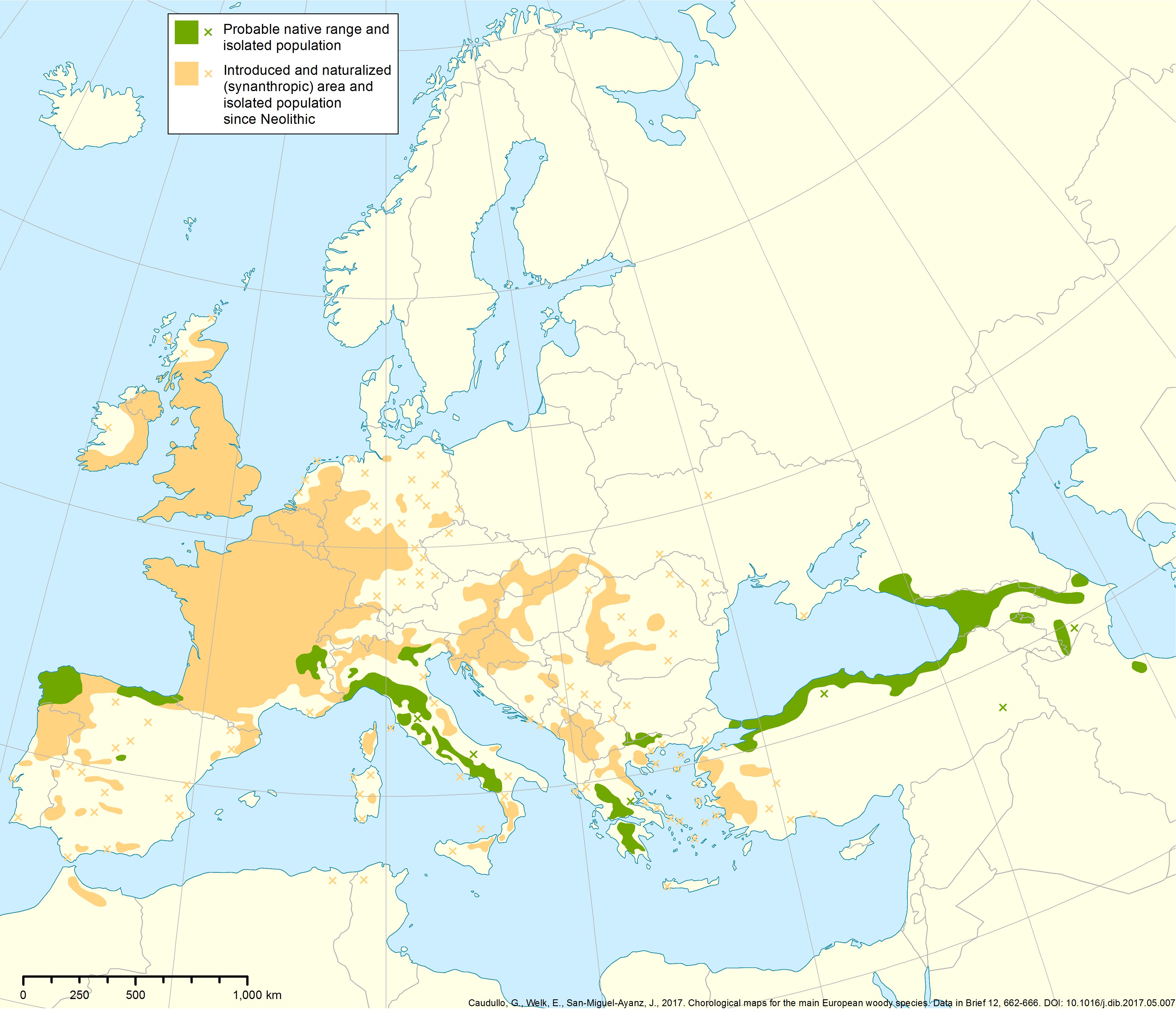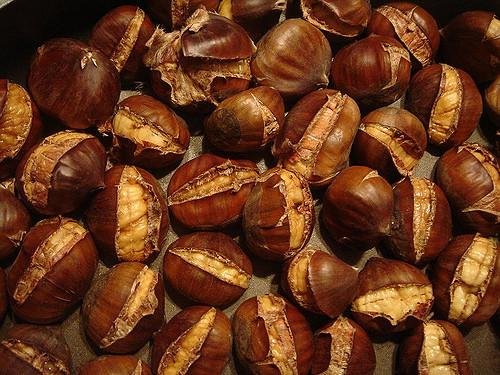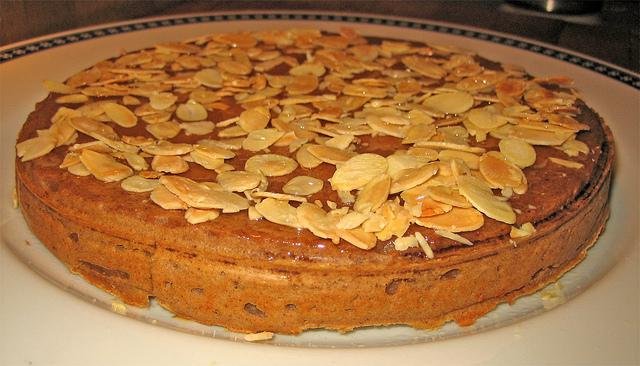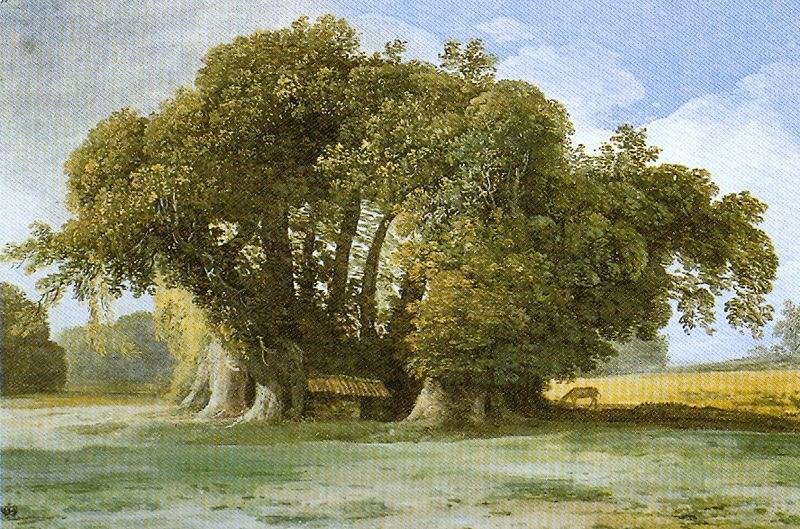Castanea sativa Mill.
French: châtaignier commun
German: Edelkastanie
Italian: castagno
Etymology of Latin species name: sativa = sown, as it has been always cultivated
Where it grows
The sweet chestnut is native to central-southern Europe (the northern Iberian Peninsula, the South of France, central-northern Italy, the southern Balkan Peninsula) and Asia Minor (western and northern Turkey, the Caucasus). It can be found at sea level in its northern range, and at up to 1400 m above sea level (asl) in Greece and 1700 m asl in Asia Minor. This tree has been widely planted and cultivated outside its natural range throughout the warm-temperate climate regions, such as South and North America and Australia.
What it looks like
The sweet chestnut is a medium-large tree, growing 30-35 m in height with a trunk of 1.5-2 m in diameter at the base. When cultivated, it can reach a very large size, with a trunk of more than 6 m in diameter. This tree is also a long-living species, and some plants are estimated to be more than 1000 years old. The leaves are long and narrow, with toothed margins. Flowering occurs in June-July. Male flowers develop in long yellowish-green catkins, with female flowers at their base, which are embedded within a small spiny green involucre (membranous envelope). Pollination is driven by wind and insects. The fruit is a brownish nut enclosed in a spiny cupule.
Uses
The sweet chestnut is a multipurpose tree, producing good quality wood, edible fruits and several secondary products such as pasture, hay, mushrooms, berries, etc. The timber is strong and durable, and can be used for construction, furniture and long poles. Chestnut wood is also used for burning and for producing charcoal. Chestnut trees are cultivated in orchards for fruit production. The nut can be prepared for consumption in many different ways: roasted, candied, boiled, dried, or milled into flour. The flowers are rich in pollen and nectar and are therefore highly useful to beekeepers for honey production.
Did you know?
- In Europe, the sweet chestnut covers an area of more than 2.5 million hectares (about the size of the island of Sardinia).
- The chestnut tree has been cultivated since the Neolithic era (4000 BC), together with walnut tree and cereals. The first unambiguous evidence of chestnut cultivation is reported in Turkey, Greece and Bulgaria, and dates back to around 2100-2050 BC.
- In about 90% of chestnut forests, the sweet chestnut is the only or the dominant species. However, chestnut forests require continuous silvicultural maintenance. In fact, in the absence of human management, chestnut stands tend to be invaded by other species and to evolve towards mixed deciduous forests.
- The largest and oldest known chestnut tree in the world is “The Sweet Chestnut of Hundred Horses” in Sicily (Italy). It is composed of three different trees splitting from a unique plant. They measure 13, 20 and 22 m in girth and share the same roots. It is not known precisely how old it is, but estimations range from 2500 to 4000 years.
Check out the European Atlas of Forest Tree Species. It has much more information about sweet chestnut and many other tree species in Europe's forests.

Distribution map of sweet chestnut in Europe. Source: Caudullo et al. 2017 - CC-BY 4.0.

Male yellowish flowers in catkin clusters. © Maja Dumat, Flickr - CC-BY 2.0

Edible nuts of the sweet chestnut. © Michael Scialdone, Flickr - CC-BY 2.0

Old sweet chestnut in the Villa Taranto Botanic Garden (Verbania Pallanza, northern Italy. © Tracy Durrant, Flickr - CC-BY 2.0

Roasted nuts of the sweet chestnut. © elif ayse, Flickr - CC-BY 2.0

"Castagnaccio" cake, made with sweet chestnut flour. © fugzu, Flickr - CC-BY 2.0

Painting by Jean-Pierre Houel of "The Sweeet Chestnut of Hundred Horses" as it was in the 18th century: a unique plant with a circumference of 58 m. © Louvre Museum ARK, Wikimedia - Public Domain

